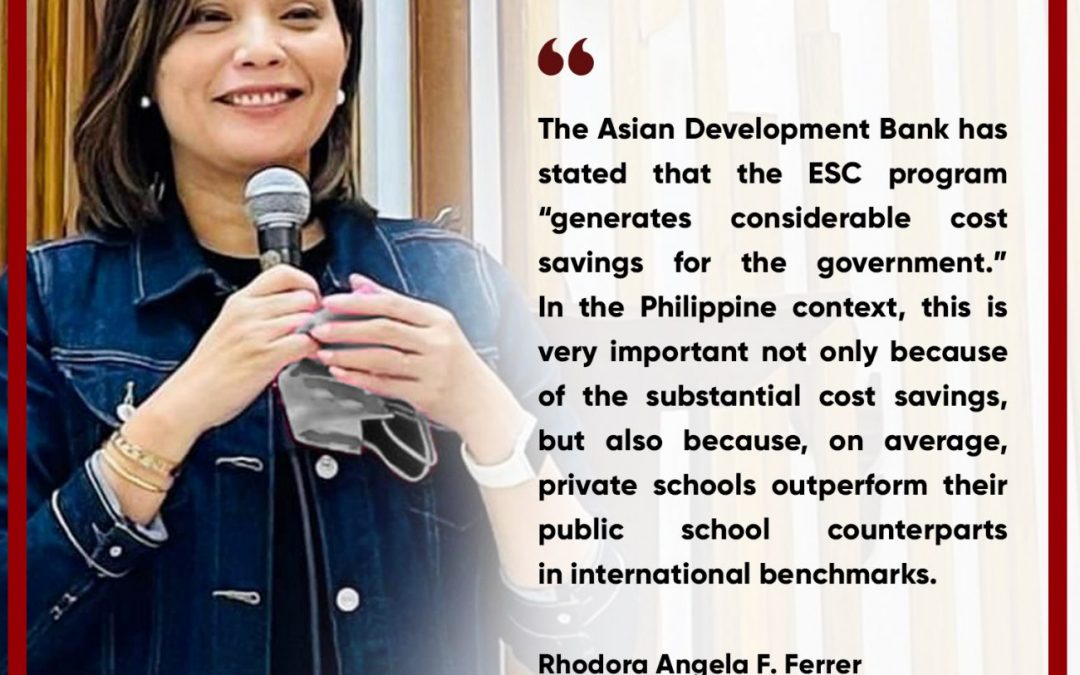The 1987 Philippine Constitution recognizes the complementary roles between public and private institutions in the education system. Much has been said about the concept, but operationalizing complementarity—making it work on the ground—continues to be elusive.
In 1991, the Congressional Commission on Education identified the need to “plan and support public and private education together.” Thirty years later, however, researchers still observe the “marginalization of private education” as an urgent issue. The Second Congressional Commission on Education or EdCom II may be the golden opportunity for the government to fully embrace public-private schools complementarity.
As the nation reels from several issues in the education sector, EdCom II was created to undertake a three-year comprehensive national assessment and evaluation of this sector’s performance. There are several subsidy programs implemented presently, particularly the education service contracting (ESC) scheme in junior high school and the senior high school voucher program (SHS VP), that can serve as the baseline for the development of a strategic and coherent blueprint to finally put to rest the “competition” between public and private schools.
In 1982, the Department of Education (DepEd), together with the Private Education Assistance Committee (PEAC), successfully conducted a pilot to provide a cost-effective alternative to public school expansion, beginning what is now the longest running subsidy scheme in the country. In the pilot, DepEd entered into service contracts with private schools “that would accommodate overflow students from public schools, as well as students in communities where there were no public schools, thus enabling government to realize substantial savings.”
The Government Assistance to Students and Teachers in Private Education Act or Republic Act No. 6728 in 1989 provided the legal basis for the ESC. In school year (SY) 2016-2017, the SHS VP was implemented when the K-12 law went into full effect. At present, both the ESC and the SHS VP are being co-implemented by DepEd and PEAC, which is a very important dimension of public-private partnership.
In SY 2021-2022, there were about 970,000 ESC grantees in around 3,600 private junior high schools, or about 84 percent of all private junior high school students in that school year. In the same SY, there were about 1.2 million voucher program beneficiaries in some 4,500 private senior high schools, or about 93 percent of all private SHS students. The percentages seem impressive, but the universe of private education is very small. In the same school year, only 6 percent of all students in the system are in private K-6, 13 percent in private junior high schools, and 32 percent in private SHS.
The Asian Development Bank has stated that the ESC program “generates considerable cost savings for the government.” While public secondary schooling costs the government $185 (around P8,880 at the time of the study) per student, the ESC costs per grantee only $107, or P5,233 per year. The ESC, in effect, translates to a 58-percent savings for the Philippine government. In the Philippine context, this is very important not only because of the substantial cost savings, but also because, on average, private schools outperform their public school counterparts in international benchmarks.
At present, there are initiatives to expand the ESC to the elementary level. Thus, the research on the absorptive capacity of private K-6 needs to be undertaken. The Cristina Research Foundation, Inc. recently proposed that a tripartite agreement among DepEd, local government units, and private schools be explored in the SHS VP, given that the current voucher amount is insufficient. The Joint Delivery Voucher Program-TVL (technical, vocational, livelihood) track, which is a subsidy scheme for public Grade 12 students to cross-enroll in private schools for their TVL subjects, is in transition and may need to also undergo a process evaluation.
Even at the higher education level, the Tertiary Education Subsidy program for private school students under the Universal Access to Quality Tertiary Education Act needs a process evaluation, as it hit a snag this school year due to budgetary constraints, and possibly even concerns about the program’s plausibility and implementation.
There is really much to be thought through toward making complementarity between public and private schools in the country operational. Two principles though cannot be lost in the process: the need for a level playing field, and the centrality of the learner. And, I daresay, we need to get this done right—and right now.
This article was published in Inquirer.net last May 11, 2023: https://opinion.inquirer.net/163058/making-public-private-school-partnership-work

